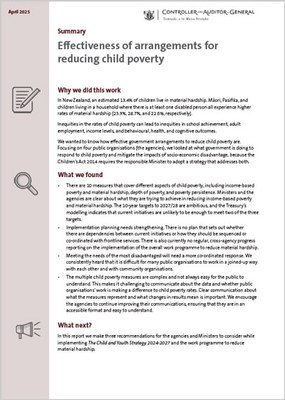Summary of our report
Why we did this work
 In New Zealand, an estimated 13.4% of children live in material hardship. Māori, Pasifika, and children living in a household where there is at least one disabled person all experience higher rates of material hardship (23.9%, 28.7%, and 22.6%, respectively).
In New Zealand, an estimated 13.4% of children live in material hardship. Māori, Pasifika, and children living in a household where there is at least one disabled person all experience higher rates of material hardship (23.9%, 28.7%, and 22.6%, respectively).
Inequities in the rates of child poverty can lead to inequities in school achievement, adult employment, income levels, and behavioural, health, and cognitive outcomes.
We wanted to know how effective government arrangements to reduce child poverty are. Focusing on four public organisations (the agencies), we looked at what government is doing to respond to child poverty and mitigate the impacts of socio-economic disadvantage, because the Children’s Act 2014 requires the responsible Minister to adopt a strategy that addresses both.
What we found
- There are 10 measures that cover different aspects of child poverty, including income-based poverty and material hardship, depth of poverty, and poverty persistence. Ministers and the agencies are clear about what they are trying to achieve in reducing income-based poverty and material hardship. The 10-year targets to 2027/28 are ambitious, and the Treasury’s modelling indicates that current initiatives are unlikely to be enough to meet two of the three targets.
- Implementation planning needs strengthening. There is no plan that sets out whether there are dependencies between current initiatives or how they should be sequenced or co-ordinated with frontline services. There is also currently no regular, cross-agency progress reporting on the implementation of the overall work programme to reduce material hardship.
- Meeting the needs of the most disadvantaged will need a more co-ordinated response. We consistently heard that it is difficult for many public organisations to work in a joined-up way with each other and with community organisations.
- The multiple child poverty measures are complex and not always easy for the public to understand. This makes it challenging to communicate about the data and whether public organisations’ work is making a difference to child poverty rates. Clear communication about what the measures represent and what changes in results mean is important. We encourage the agencies to continue improving their communications, ensuring that they are in an accessible format and easy to understand.
What next?
In this report we make three recommendations for the agencies and Ministers to consider while implementing The Child and Youth Strategy 2024-2027 and the work programme to reduce material hardship.

